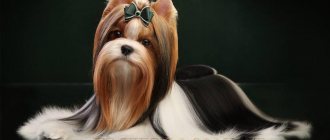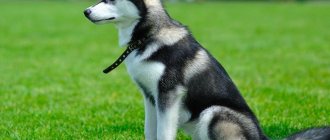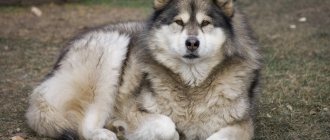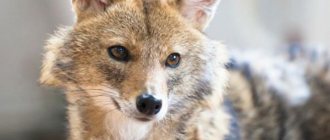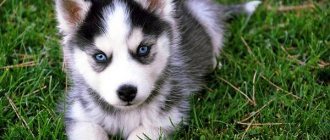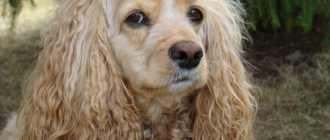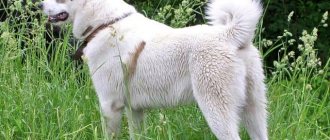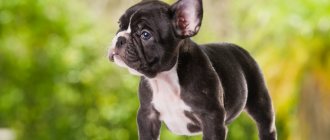Siberian Huskies are a freedom-loving breed of dog, in whose veins flows a mixture of the blood of wolves and northern dogs. The popularity of these blue-eyed dogs is constantly growing, as they are not only a human companion, but also a loyal friend and reliable assistant. In appearance they are similar to a wolf, but their character is friendly and peaceful. This was achieved through long-term selective selection, since the history of the origin of the husky is very mysterious and mysterious. But to understand it, it is worth studying all the stages of formation in order.
The history of the appearance of the Siberian Husky breed
Huskies belong to a group of sled dogs bred by the Chukchi in northeastern Siberia. The most distant ancestors of dogs are wolves. From these “forest orderlies” came the Siberian sled huskies, and from their crosses with the dogs of the Native Americans of Alaska, the huskies originated.
Smooth-haired Siberian huskies were brought from Chukotka to North America as draft animals and hunting dogs. Here the crossing of breeds continued, resulting in a whole scattering of “stars” of sledding sports. Huskies combine the best qualities of northern breeds: speed, reliability, endurance, high intelligence, the ability to survive in harsh conditions and loyalty to the owner. Frost-resistant animals are not afraid of cold winters with temperatures down to minus 35-40 degrees.
Health status
Huskies rarely get sick. However, dogs often inherit genetic diseases that they can pass on to their offspring. The animal must undergo a timely medical examination and receive the necessary vaccinations. The owner can independently monitor the pet’s health by checking its ears, teeth and eyes. It is necessary to monitor the Husky's body weight. When you become overweight, diabetes develops.
Since representatives of the northern breed do not tolerate high temperatures well, on hot days you need to walk your pet early in the morning and late in the evening. One of the most unpleasant habits of a husky is eating feces. The owner must stop any attempts to consume excrement.
Huskies rarely get sick, but they inherit genetic diseases.
With proper care, a dog's life expectancy is 12-15 years. In some cases it can reach 18-20 years.
Skin diseases
A lack of zinc often leads to the development of atopic dermatitis and dermatosis, which are manifested by the appearance of bald spots.
Nasal depigmentation may occur. But this disease does not pose a threat to the pet's health.
Eye pathologies
Some dog trainers believe that problems are more common in huskies with blue eyes. Representatives of the breed can be diagnosed with:
- primary glaucoma;
- entropion of the eyelid;
- cataract;
- superficial keratitis;
- corneal dystrophy;
- progressive retinal atrophy.
To protect the health of the pet, the owner must wipe the dog’s eyes with a special solution at least once a week. You can use preventive drops prescribed by your veterinarian.
Diseases of the cardiovascular system
Dogs over 7 years of age are often diagnosed with hypertension. Males are more prone to the disease. The main symptom of hypertension is red dots on the whites of the eyes.
Diseases of the cardiovascular system occur in dogs from 7 years of age.
Neurological pathologies
Representatives of the breed are prone to epilepsy. Its symptoms include loss of consciousness and convulsions. Epilepsy manifests itself in young individuals from 7 months to 3 years. The pathology cannot be cured. However, with the help of drug therapy, veterinarians control the attacks or reduce their number to a minimum.
Dogs older than 8-10 years old suffer from degenerative myelopathy, in which nerve tissue is destroyed. The pet's movements become slow. The animal has difficulty getting up. The progression of myelopathy leads to complete paralysis of the fore and hind limbs. The pathology is considered incurable.
Who are Huskies, what breed?
In short, all varieties that descended from northern dogs that were distinguished by strength and endurance belong to the husky family. It is difficult to call them a separate breed. This is the general name for an ever-changing crossbreed of the fastest sledding breeds.
"Husky" or "husky" is a shortened version of the word "huskimo" ("Eskimo"). This is how the sailors of English merchant ships pronounced the name of the northern people. In the mid-nineteenth century, the dogs that Eskimos and Inuit used in everyday life began to be called the same.
Officially, information about the dog breed was established by the standard in the thirties of the last century. Conventionally, representatives of the breed can be divided into three groups:
- workers;
- racing;
- exhibition
The “oldest” and rarest are working dogs. These are amazingly hardy animals. Racing dogs are athletes with long, well-developed legs. Their main advantage is speed. Exhibition specimens are talented actors with very expressive “faces”. This is a show dog that knows how to “keep a mark” on any audience.
Preparation
Preparation is an important part of your participation in the pregnancy and maternity process of your pet, so you need to treat it with the utmost care. Read the necessary information in advance and select videos on the topic that suit you so that you know what exactly is ahead of you.
Stock up on everything you might need in advance:
- Set up a nest and pen for the babies.
- Discuss with your veterinarian in advance and purchase the necessary medications. These must include painkillers, antispasmodics and medications that stimulate contractions.
- Sterile gloves.
- Gauze napkins.
- Silk threads disinfected in alcohol.
- Warm heating pad.
The main thing is to prepare for the process mentally. Remember, the dog considers you higher in the hierarchy, which means it relies on you. If you show her that you are nervous or afraid, this will rub off on her.
Features of the breed and distinctive features of the Husky
Overview of the characteristics of a pure breed (the rating is indicated in parentheses):
- aggressiveness – low (1 point out of five);
- training – difficult (2 out of 5);
- activity – very high (5 out of 5);
- health – good (4 out of 5);
- intelligence – high (4 out of 5).
Every husky is an individual from birth. He will give his owner love and loyalty, but in return he will demand the same. The shaggy fidget is always in search of adventure (on his own or his master's head). The former sled dog “found himself” in modern winter sports. She easily gets along with children and family members, considering them her pack. Indispensable as a companion and faithful companion, but rarely used for hunting.
The hunting instinct of smart dogs has not gone away, but they rather get food for themselves than help people. That is, finding and driving game is not a problem for them, but delivering it to their beloved owner is not always possible. The guards among them are also so-so. No, they will protect from attack in case of danger, but protecting the territory is not their strong point. Dogs are too good-natured; they would rather play with an intruder than drive him away.
The breed is also not suitable for service dog breeding: the pet’s extraordinary intelligence and independence force it to make decisions on its own. Who cares what the owner wants if a smart dog already knows what to do. In addition, a service dog must be able to attack a person (for example, when detaining a criminal). Attempts to unblock aggression often lead to mental disorders of the animal. A powerful and fast husky with a broken psyche is a serious danger for everyone, including dog handlers.
Training and education
It is necessary to start raising a Husky from the first day this dog appears in the house. This will allow you to accustom your wayward dog to basic commands. At the age of six months, it is recommended to entrust the pet to a professional dog handler who can direct the dog’s stupid energy in the right direction.
If this is not possible, training should be carried out independently. In this case, you should adhere to the following recommendations:
- One line of education. All family members must adhere to the same line of behavior, otherwise the dog will not be able to understand why he is either praised or scolded for the same thing.
- The use of physical punishment is unacceptable. Carrot and stick behavior is not acceptable with Huskies. When completing tasks, the dog should be rewarded with a treat, and if it is not completed, its attention should be switched.
- Multiple repetition of commands. You can achieve precise completion of a task only by repeating it several times a day. At the same time, the owner’s task is to interest the pet in performing them.
- Increased physical activity. Judging by history, Siberian Huskies have high endurance. And in the absence of great physical activity, their energy is destructive. Therefore, the more the dog exercises, the healthier and more active he will be.
What is the purpose of the Husky breed?
Huge working huskies were bred primarily as a means of transportation in the harsh Arctic terrain, where ordinary draft animals are unable to survive. But the matter was not limited to transportation alone. Huskies turned out to be real hunters, no worse than a trained hound.
Now the sledding and hunting past of hardy dogs is no longer relevant. The modern purpose of the husky: sport and tourism. Some small species have become decorative companion dogs; medium-sized dogs are famous as excellent guards and hunters. For large varieties, owners have come up with alternative sports that bring pleasure to both dogs and humans:
- Skyjoring or skijoring (from the Norwegian "to pull skis"). This is one of the sledding disciplines. The dogs do not pull a traditional sleigh or sled, but a skier. You don’t need a whole team for this; one or two dogs are enough. This sport has recently been included in the World Championship list.
- Karting. An urban version of dog sledding. The dog pulls a light cart with cargo or a passenger.
- Bike joring. Instead of a sled or cart, the team is attached to a bicycle. One dog or the entire team can tow a cyclist.
- Canicross. In this sport, people decided to abandon any means of transportation, relying only on their physical abilities. The dog tows the person by a rope attached to the runner's belt.
Four-legged beauties are recognized movie stars. Charismatic dogs have become mascots of many Canadian and American universities. And they invariably remain faithful comrades and devoted defenders for everyone who loves them.
Existing varieties and their differences
Aboriginal dogs living in Chukotka still transport cargo, but this tradition is preserved only in some settlements.
Breeders from America and Russia who breed huskies rely on different qualities:
- attractive exterior from the USA, allowing for deterioration in performance;
- working qualities on the part of the Russian Federation, which prevail in importance over the attractive appearance of the animals.
Depending on the purpose of breeding, the breed is divided into 3 varieties:
- Exhibition. The exterior is determined by the kennel club. European representatives have graceful features, while American ones are famous for their massiveness. These dogs have a short muzzle, which gives them an attractive appearance. Due to the narrowing of the nasal passages, thermoregulation is disrupted, which prevents the warming of frosty air. Such dogs are bred exclusively for show careers and are not “workhorses”.
- Racing. They have short fur and long legs, allowing them to develop very high speeds. Their exterior is specific and inferior to show dogs. They are used in harness racing in conjunction with other relatives.
- Workers. They are used to transport goods and people, and are practically no different from their ancestors. They are inferior in speed to racing ones, do not shine with beauty, but have amazing endurance and intelligence.
Despite the fact that the official standard still defines a “working” appearance, deviations towards the exhibition or racing variety are considered acceptable.
The maximum compliance with the standard can be seen among the British.
In addition to classic sledding and harness racing, other sporting events have been invented for modern representatives living within the city:
- hiking, which involves long walks along forest paths with hiking equipment;
- bike joring, which replaced the sled with a bicycle;
- skijoring, which allows only one dog to pull the sled;
- karting, which involves transporting a cart with a person or cargo;
- canicross, where a dog pulls a running person and safety is regulated.
Popular varieties of husky
The scientific description of the pet is quite dry: a strong straight back, a chest of medium width, a slightly sloping croup, strong limbs. But can this portrait convey the charm of an intelligent and friendly dog?
The most popular types:
- Siberian (medium breed, companion).
- Alaskan (mixed breed, half husky, half malamute, bred for sled dog competitions).
- Klee Kai (“apartment” pet, companion, watchman).
- Sakhalin or Shiba Inu (large breed, hunter, companion).
- Japanese or Akita Inu (guard, not suitable for running).
- Samoyed dog (show breed, companion).
- American Eskimo (“apartment” dog, guard).
All species are distinguished by their good disposition, very attractive appearance, unique style and high intelligence.
Siberian
Contrary to their name, Siberian Huskies come from the northern regions of America. They were bred from the East Siberian sled dogs brought to Alaska in the nineteenth century and the local hardy Indian dogs. These were the times of the Gold Rush, when people needed strong and reliable companions. The first standard was adopted in 1930, but the breed received recognition from the FCI (Federation Cynologique Internationale) only in 1966.
Akita Inu
Akita Inu is called the Japanese Husky. This breed was bred on the island of Honshu in the Akita province. The animal's ancestors were used to hunt large animals (boar, deer, bear). Now the breed is considered semi-functional (not quite a hunter, but on occasion it can). The impressive size of the dog is suitable for the role of a guard, but his good-natured nature does not allow him to perform such work.
Alaskan
The Alaskan Malamute is the fastest, largest and most powerful representative of the breed, capable of running at speeds of more than 30 km/h for three days. The species was not bred in Siberia, but in Alaska. This is the most expensive mestizo in the world. It has dense short hair. They treat people with love and respect, are curious and playful.
Klee Kai
This is a relatively “young” breed, bred in the 70s of the last century by American breeders. Husky and Spitz mixes are small in size and have short hair of black and white, white and gray or red and white color. The Klee Kai was bred as a companion and watchdog. This is a beautiful little "apartment" breed.
Husky Samoyed
Large fluffy huskies (Samoyed, Samoyed, Sammy) are native breeds. Outwardly they are very reminiscent of a polar wolf. At the end of the nineteenth century, several individuals of northern dogs were brought to England from Siberia and the Urals, which became the founders of the European breed. There are now seven breed standards for the Samoyed: English, International (FCI), Canadian, New Zealand, South African, Australian and American.
American Eskimo
The American Eskimo dog was obtained in the USA from a cross between a native species and a German Spitz. Most often, the dog is completely white, covered with very thick hair. “American” is not large in size, suitable as a pet, and takes on the work of a watchman and security guard. Can be used as a watchdog (drug detection) and takes part in sports competitions.
Agouti
Agouti is the name of the phenotypic color of the dog, not a separate variety. This word denotes the specific name of a small rodent with brown-gray fur. The origin of the “Agouti gene” is associated with primitive breeds, northern sled dogs. Based on this material, new species with black, gray, yellow and red wool were bred.
Sakhalin
The Sakhalin Husky is a Japanese sled dog whose origins are related to the Akita Inu and the Japanese Spitz. The view is very unpretentious. The dog is devoted to his owner, but loves freedom - he strives to escape at the first opportunity. An obedient dog loves his owner, recognizes him as the leader of the pack, but as soon as he gives in, he immediately “goes on the run.”
Historical reference
It is known that people used dogs as draft force more than 4,000 years ago, but documentary evidence of this fact dates back 1.5 years ago. Domesticated wolves, jackal-type dogs, aboriginal dogs and all kinds of crosses have shared shelter with humans for centuries. Later, from this huge diverse group, dogs were identified that were similar in working qualities and appearance. Thus, breed groups of northern aboriginal dogs were formed, which became the ancestors of modern pets. The Siberian Husky dog breed is rightfully considered the most famous among the “northern pets”, although in recent years Laikas and Malamutes have been steadily rising in popularity ratings.
This is interesting! As you know, naming breeds by their distinctive characteristics is considered the norm in cynology to this day. Translated from English, the word “husky” is interpreted as hoarse or hoarse. Representatives of the breed rarely bark; they usually make growling sounds similar to a hoarse bark.
The origins of the Siberian Husky are somewhat obscure. At the time of the birth of the breed, absolutely all Eskimo dogs with thick fur and polar colors were called huskies, without dividing the dogs according to exterior characteristics. Later, a small distinction did appear; Laek, whose height reached 51 cm, was also included in the breed group. According to available data, the history of the breed began in Greenland, where the local population hunted and needed strong, hardy dogs.
Difficulties in describing the history of the breed are associated not with the breeding technique, but with the lifestyle of the “breeders”. From the available data, the Chukchi and other northern peoples used dogs similar to modern huskies as early as 3,000 years ago. But these facts have not been confirmed, since writing was (and remains) alien to the northern peoples. Denying progress and following established traditions, the Eskimos continued their aboriginal way of life even during times of great progress.
Northern dogs living in the region were divided into two types. The first were adapted for herding deer and protecting homes; they lived with people on lands remote from the coast. Cattle breeders' dogs were larger and more powerful than the four-legged animals that lived in the coastal zone, from which, in turn, the Siberian Huskies originated. The peoples living on the shores of the Northern Ocean did not leave their territories and lived by hunting and fishing. For the Chukchi, who “settled” on the coast at the time of the birth of progress, the war for the Bering Strait became a rather difficult test. The fighting pushed local residents deeper into the continent, thereby distancing them from the “hot” hunting grounds. This is where the need arose for strong, hardy and “economical” dogs that could carry a team to the fishing site and back.
This is interesting! Huskies apparently inherited their independence and disobedience to violence from their first owners. The forces of the Russian Empire tried to “absorb” the Chukchi territories several times, but to no avail. The peoples either did not agree to join (in the case of peace proposals), or left the place of conflict and continued their everyday lives.
Attempts at “suppression” ended only in the 18th century, when Russia granted independence to the northern people. However, the bright future did not materialize; in the 20th century, the USSR again encroached on the independence of the Chukchi. It was about an invasion of lands that from time immemorial “belonged” to hunters. The fact of importing dogs from Europe and Asia had an extremely negative impact on the purebred husky.
By the will of the Union, the established rules for breeding dogs were “redrawn”. All northern quadrupeds were divided into 4 groups, 3 of which were used for hunting. Eskimo huskies did not fit into any of the categories; they were small for sledding and weak for hunting. By banning breeding and later beginning the destruction of the breed group, the “iron will” of the Soviet Union eradicated even the hope of preserving the primary, pure gene pool of Siberian Huskies.
History always develops in turns and people regretted that they did not value light, easy-to-keep dogs. The moment of regret coincided with the discovery of gold deposits in Alaska. The speed, mobility, endurance and unpretentiousness of dogs have increased dramatically in price. The remaining, or rather, surviving huskies suddenly acquired value, and a serious “hunt” began for them.
Varieties of color
A short list of color options:
- Black. Absolutely black color is rare. There may be patches of white on the muzzle, chest, paws and tip of the tail.
- White. Rare snow-white color. The undercoat and coat are the same white color.
- Black and white. Approximately equal parts black and white wool. The undercoat is either completely black or snowy white. The upper part of the body is “filled” with black from the back of the head to the tail. The paws, chest, and belly are predominantly white.
- Grey. A common species with a gray coat and a silver, cream or beige undercoat.
- Silver. Cool color without interspersing warm tones. The undercoat is silver to snow-white, the coat is light gray to silver.
- Copper or chocolate. Rich chocolate tone with a copper tint.
- Ginger. The overall tone is lighter than chocolate. A pronounced red color, similar to a fox fur coat.
- Pale yellow. Warm pastel tone from light brown to fawn. The undercoat is also fawn or light cream. A reddish tint is unacceptable.
- Wolf grey. Warm gray tones interspersed with red, fawn or yellow. The undercoat is only beige.
- Sable. A very rare color with a bright copper undercoat. Each hair is beige-fawn at the root and dark gray or black at the end.
- Agouti. Shades from gray to deep black. Possible stripes. The undercoat may have a warm creamy tint. There are reddish areas on the paws. A distinctive feature is the black tip of the tail and a dirty dark “mask” on the muzzle.
In addition to the listed combinations, there are Isabella, saddle, black and tan, Splash Coat, piebald, harlequin and other color options.
What do purebred huskies look like?
The appearance of the husky is fixed by the breed standard. This is a medium-sized dog with harmonious proportions. The head is wide at the top, tapering towards the nose and then into a strong neck. Intelligent eyes, often emphasized by pronounced eyebrows, give the animal individuality. Powerful and muscular short-haired paws make the Husky an excellent runner.
A pointy-eared, fluffy dog of the northern breed, with thick fur and a curled tail, looks a bit like a Spitz. At rest, the tail straightens and falls slightly below the body. There are short-haired species and dogs with very long hair. For example, the Siberian Husky is considered shorthaired. The thick coat with a very fluffy undercoat can be black and white, pure black or pure white. There are color options from bright red to silver tones. The purebred dog's conformation standard also allows for stripes and markings.
Dimensions and weight of the dog
The weight and height of a husky depend on the specific subspecies. There are very small ones, and there are huge working animals. On average, the height at the withers is within the range of 50-60 cm, and the weight is limited to 20-35 kg.
Table of parameters of popular representatives of the breed.
| Breed variety | Height, cm | Weight, kg |
| Siberian | 54-60 (boys) 50-56 (girls) | 20-28 (boys) 16-23 kg (girls) |
| Alaskan Malamute | 56-65 | 32-45 |
| Sakhalin | 55-65 | 30-40 |
| Klee Kai | 42 (max) | 10 (max) |
| Japanese Husky (Akita Inu) | up to 67 (boys) up to 61 (girls) | 40-50 |
| Samoyed | 54-57 (boys) 50-53 (girls) | 25-30 (boys) 17-25 (girls) |
| American Eskimo | 22,9 – 48,3 | 2,7-15,9 |
Head, eyes and ears
The head is medium in size and ends at the top with a slightly rounded crown. Medium-sized triangular ears stand upright. The almond-shaped eyes, set slightly askew, are striking in their intelligence. Eye color is brown or blue, sometimes there are dogs with eyes of different colors. These three color options are a sign of the breed in Northern Huskies. Other colors are considered defective.
Teeth, jaws
The lips, which fit tightly to the powerful jaw, cover the sharp teeth. For exhibition specimens, correct bite is important. According to the standard, it must be of the “scissors” type.
Neck and body
The convex neck of medium length smoothly merges into a strong body. A straight, strong back and broad chest are the hallmarks of a riding animal. The portrait of an excellent athlete is completed by a developed lower back and slightly sloping croup.
Tail, limbs and fur
The husky's tail is a bit like a fox's. He is just as fluffy and beautiful. Powerful compact paws have an oval shape. The coat is long, not harsh, thick, with a fluffy undercoat.
Nutrition rules
The metabolism of Siberian huskies is represented by its specifics. There are two options for creating a menu for this dog:
- The first option is natural products.
- The second option is dry food.
It is strictly forbidden to mix these two types of feeding, since a mixed type of feeding provokes the development of gastrointestinal problems. This, in turn, negatively affects the entire body. In addition, you should remember that feeding the dog before walking and physical activity is prohibited. This can cause volvulus.
Diet
Dogs of the breed described above have the opportunity not to strain the liver when consuming fatty foods. As you know, northern dogs, including huskies, need protein and fatty foods. Huskies are not known for their increased appetite, but nevertheless there are real gluttons.
60-70% of a dog’s diet should consist of meat and meat products. You can give your dog the following types of meat:
- Chicken.
- Beef.
- Olenin.
It is better to avoid pork and lamb.
As for the shape and type of meat, it is not recommended for the animal to grind the meat into minced meat. Preference should be given to meat cut into pieces.
The diet should contain by-products. By-products are represented by liver, heart, and lungs. They are rich in vitamins and microelements.
It is necessary to feed your dog by-products regularly, but not daily. The diet also includes porridge. However, Siberian Huskies are allowed to be fed only three types of cereals:
- Oatmeal.
- Buckwheat.
- Rice.
The share of porridge in a dog’s diet is 10%.
Fish, eggs, dairy products, and vegetables are also allowed for consumption.
Prohibited Products
As for prohibited foods, they are represented by milk, spicy, fried foods, and fatty meats.
Description of the character of the Siberian Husky
Huskies need movement. This active handsome guy resembles a “shaggy meteor” in the first six months of his life, but when the husky turns 2 years old, his character begins to change, his hyperactivity gradually subsides.
All northern dogs are good-natured and independent by nature. A smart pet chooses the strictest family member as a leader, even if a completely different person takes care of him. The dog's friendliness does not allow him to become an ideal guard. The Siberian Husky does not accept orders, but always responds to requests. The dog considers any concessions to be weakness and immediately assumes the role of leader (i.e., does as he wants).
The dog strictly adheres to the established rules and expects the same from the owner.
Relationships with children and other animals
Huskies are not naturally aggressive. A well-trained dog usually tolerates childish advances patiently and is affectionate with owners and guests. However, we must not forget about the size and agility of the pet. An active dog may accidentally push or knock over a small child. There is no need to be afraid of an attack, but it doesn’t hurt to keep an eye on the interactions between children and animals.
Hunting habits should not be confused with aggression. The dog is capable of tirelessly chasing all the surrounding cats, but loyally being friends with “his” domestic cat. Dogs do not always get along with their own kind. Boys living in the same house are able to sort things out peacefully, while girls will fight “to the death.” The fact is that the natural leaders in this breed are females. They solve the problems of the pack, lead and guide their charges. However, no matter how hostile the dogs are, when working in the same team they forget about differences: work is more important than personal relationships.
Husky's bad habits
The pet can “chat” in its own language, but barks very rarely. But howling suddenly and giving your neighbors a heart attack is always welcome. The dog is a “seasoned repeat offender” - constantly ready to escape. Disadvantages include the desire for destructive activities. Long walks, active communication with your pet and regular exercise will help correct the situation.
Husky behavior
An independent pet can easily survive in the wild, providing food for itself and its offspring. The hunting instinct is especially strong in girls. Those who keep a “shaggy horse” in the suburbs or rural areas should remember: the pet is capable of starting a hunt not only for “ownerless” mice and moles, but also for neighboring animals. Shaggy, handsome huskies love to “talk.” They have their own language with unusual sound combinations, they are able to pronounce all “human” vowels.
Husky predisposition to diseases
Although huskies have true Siberian health, they can develop characteristic diseases. More often they are caused by the activity and energy of the pet. And, accordingly, they manifest themselves in the area of the extremities. The joints are usually affected. The most common disease of hereditary origin is hip dysplasia.
Other characteristic pathologies are:
- eye diseases: corneal dystrophy, glaucoma and cataracts;
- thyroid abnormalities;
- diabetes.
Traumatic diseases for Siberian Huskies are characterized by tendon sprains, bone cracks in the limbs, and other problems of the musculoskeletal system. To prevent them, you should organize moderate active loads and ensure that the dog is not overloaded during training.
Deworming against helminthic diseases and vaccination against dangerous diseases of viral and bacterial etiology are mandatory to maintain health. At the veterinary clinic you can get vaccinations against distemper, viral hepatitis, parvovirosis, infectious enteritis, rabies, and leptospirosis. For young pets under the age of 1.5-2 years, it is recommended to use monovalent biological products for each disease separately. Individuals over two years of age are allowed to use polyvalent vaccines against several diseases at once.
Keeping and caring for a husky dog
Huskies are a northern breed; they tolerate any frost well. But this does not mean that you can leave a small puppy in an open enclosure on a bare concrete floor in winter. Under natural conditions, the mother lines the nest with her own fur (heavy shedding after birth). Adult dogs, even smooth-haired ones, can really sleep peacefully in the snow. Moreover, they are able to warm the owner and help him survive a frosty night. They say that two dogs are enough for a person to calmly withstand a temperature of -50°C.
The scourge of all frost-resistant animals is lazy heat. Oddly enough, thick wool provides reliable protection against it. The undercoat does not allow heat to pass through to the skin, creating a heat-insulating air layer. But there is also a downside: physical activity causes heating “from the inside.” Heat is not removed through the skin, since wool does not allow it to pass through. Conclusion: in the summer it is worth limiting the activity of your pet, both smooth-haired and long-haired, and also make sure that he always has access to water.
Caring for your teeth and ears
In the first months of life, teeth do not require any care, then teeth change. From about one year of age, regular weekly dental cleaning is recommended, especially for show animals. Ears should be examined daily. Brown sulfur should be visible inside. This is a natural protection for the ear canals and does not need to be completely removed. The optimal ear cleaning schedule is once every 2-3 weeks.
Grooming
The fur of a healthy and well-groomed dog does not have a pronounced odor, as it cleans itself. The main thing in grooming is to comb even a smooth-haired husky on time. Usually this is done once a week, but in spring and autumn (during molting) the owner will have to comb out the undercoat daily.
Nail care
Ideally, the claws should grind down on a hard surface on their own, but this takes time. Short outings to perform natural necessities are not enough. You need to cut the claws as soon as they begin to bend inward (twist), literally a couple of millimeters at a time. It is safer to trim more often, but little by little, so as not to hurt the skin.
Is a Husky suitable for living in an apartment?
The best option is an aviary in a private house. Locking him within four walls is dangerous. The dog cannot stand loneliness, he needs a pack. The Klee Kai is more suitable for urban conditions. This is a decorative breed with a good character, able to get along with children and other pets. Single people can also get one, provided that the dog is given enough time and attention. Without communication, a Klee Kai turns into a grumpy, harmful old man.
Balanced diet
Dogs are unpretentious when it comes to food. If you don't pay attention, your pet will happily rummage through food waste, which can lead to poisoning. Feeding both large working dogs and small Husky dogs can include prepared foods and natural products. If the diet consists mainly of ordinary foods, the diet should contain at least 50-60% meat. Beef (preferred option), rabbit, turkey are suitable. Lamb and pork are prohibited, even if the pieces have almost no fat. The meat can be lightly boiled or served raw.
Chicken can cause allergies in dogs. In addition, its tubular bones are dangerous to the health of the pet.
Husky memory and intelligence
Smart, independent pets learn quickly. They remember commands easily and are trainable. But these cunning animals are only obedient as long as they are on a leash. Once you unfasten the carabiner of the collar, the real “fun” begins. At best, the husky will run circles around its owner, at worst, it will disappear into the foggy distance.
Husky bathing
You can wash your paws without detergents after every walk. It is necessary to completely bathe your pet very rarely, a couple of times a year, since there is almost no smell from the fur. The more often you wash the animal, the stronger the characteristic odor may become. Water procedures disrupt the fat balance of the skin. You can dry your dog with either a towel or a hairdryer (if the dog is not afraid of its buzzing). The final stage is combing.
Husky breeding
To obtain healthy offspring, you need to select the appropriate manufacturer. When an adult male with good working characteristics and a friendly character “gets acquainted” with a sexually mature girl, the chances of offspring increase. The date should be scheduled for 12-14 (according to other information - 20) days after the start of estrus. After mating, it must take several days for the results to become obvious. If the dog does not allow suitors near him, there is no need to repeat the mating. Pregnancy lasts 60-63 days.
Training and raising a dog
The best exercise for dogs is sledding. In winter, the pet happily harnesses itself to a sleigh; in summer, it tows a bicycle. However, giving free rein to a dog for a walk is another test for the owner. An independent character and curiosity will definitely lead the dog to “exploits.” Breeders and dog trainers recommend having something tasty ready and using a clicker. If the dog deigns to return to its owner, it cannot be scolded; on the contrary, it must be praised and treated, reinforcing and encouraging obedience.
Disease susceptibility and life expectancy
For the most part, dogs are renowned for their good health. Certain species may have problems unique to them. Alaskan Malamutes, for example, may suffer from retinal diseases or have a congenital deformity of the larynx.
Huskies, just like their smooth-haired or short-haired counterparts, can catch colds. A thick fur coat takes a long time to dry after bathing, so you should not let your pet go outside without being “dry.” Regular parasite cleanings and preventive visits to the veterinarian are also needed.
Life expectancy is on average 10-15 years. By dog standards, this is a very impressive period. Small dogs can live longer than large dogs. It is advisable to take older huskies to the veterinarian more often in order to notice possible health problems in time.
Conditions of detention
Siberian Huskies are similar to wolves not only in appearance. Dogs of this breed value freedom of movement. They cannot sit on a chain, they value space and the opportunity to run around without a collar.
You can keep a husky in a city apartment, but subject to a number of conditions. First, the dog needs daily long walks in the morning and evening. Secondly, the dog should not be left alone for a long time, otherwise it will find something to do, and it is possible that it will have devastating consequences for the interior of the house. Thirdly, Siberian Huskies are powerful dogs, and therefore, during walks, they need to be provided with the necessary level of physical activity. Otherwise, the dog will simply waste away and get sick.
The optimal condition for keeping these freedom-loving dogs is to keep them in an enclosure, which should be spacious and have no gaps at the bottom to prevent the pet from leaving without permission.
What to feed your husky
Siberian Huskies require special attention to their diet during the period of maturation and growth:
- until they reach 2 months of age, the frequency of feeding should be six times a day;
- from two to four months, food should be given five times a day;
- up to four feedings are necessary before the age of six months;
- Until the dog reaches 10 months of age, feeding is carried out three times a day.
After ten months and throughout the rest of their life, it is enough to feed Husky dogs twice a day.
If specialized dry food and canned meat are chosen to feed young and adult Siberian Huskies, then preference should be given to such products with at least premium quality. Dog handlers and veterinary specialists are convinced of this, guided by the fact that such food contains less starch, which is harmful to the body of these northern dogs.
How to choose a puppy, who is better - a boy or a girl?
Young ladies are recognized leaders. They are tougher and faster than boys, but they have to put up with a difficult character. Boys are more powerful and more passionate, they are better suited for sports. The appearance is also important: cynologists do not recommend the Alaskan Malamute for living in an apartment, and the small Klee Kai was bred precisely for this purpose.
The decision also depends on the purpose for which the pet is purchased. A girl of pure breed can bring considerable income, since Siberian Husky puppies are in demand. And a boy of average condition is most often castrated.
Interesting Origin
Huskies, so popular all over the world today, can boast an interesting and surprising origin story. In fact, the history of the breed with northern roots goes back a long way.
The Siberian Husky is one of the oldest breeds, which, according to some experts, is three thousand years old. The homeland of this dog is the frosty and cold Siberian region, which is inhabited by the Chukchi. Since ancient times, huskies have been used to transport light loads. The malamute was responsible for transporting large loads. Women were responsible for breeding and raising the dog and allowed the dog to live at home. That is why people highly valued such a quality as the ability to find a common language with a person. It is worth noting that this quality was valued as highly as the ability to work in a buckle. The dog is a universal soldier with a kind heart and amazing performance.
In the 19th century, it gained popularity in many countries, and not only in Europe. However, unfortunately, not many people can cope with the daring nature of Siberian Huskies. It is for this reason that dogs often change their place of residence and end up in shelters.
Photos of Siberian Husky puppies
Cost of husky puppies
The average cost of a dog without a pedigree in Russia is 6-10 thousand rubles. It is fashionable to find cheaper options “from hand”, but this is risky: the state of health, the presence of vaccinations and the necessary skills are often confirmed only by the words of the seller.
Cost of some purebred species (in dollars):
- Siberian – up to 1,000;
- Alaskan – 3,000-10,000;
- Klee Kai – up to 8,000;
- Japanese (Akita Inu) – 600-800.
In a nursery, a child from ordinary parents can cost 20-30 thousand rubles, and a descendant of champions can cost 40-50 thousand rubles.

